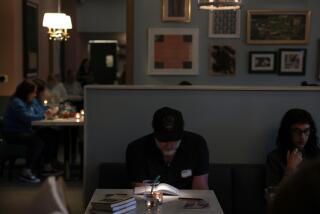Q & A
- Share via
Jim Trelease, author
“The Read-Aloud Handbook”
In 1979, Jim Trelease published “The Read-Aloud Handbook,” which sold only modestly until it was discovered by newspaper advice columnist Abigail Van Buren. After “Dear Abby” praised the book it became a best-seller, and today Trelease travels the nation speaking to adults about the benefits of reading. His latest tour has included stops in Tustin and Irvine, and he will be in Rancho Santa Margarita tonight. He spoke with Times correspondent John Pope about his work.
Q: You’ve said that this country creates too many “schooltime readers” and not “lifetime readers.” Could you elaborate?
A: About half of the adults in the U.S. didn’t buy a book last year, and about 55% of the homes won’t see a daily newspaper today, but 80% [of Americans] can read on an average level. What’s happened is that they’ve been taught to read, but when they didn’t have to, they stopped. A lifetime reader picks up his diploma and says, “Now I can read what I want to read,” . . . and once you’ve learned to want to read, you can teach yourself anything. But if kids make a displeasing connection with print, they don’t come back to it. Nobody has favorite vowels and consonants, they have favorite stories. So if you only teach them how, but not to want to read, you’ve only done half the job.
Q: So what’s the solution?
A: The easiest, fastest and cheapest would be to have every teacher and parent reading aloud to kids. Overwhelming evidence of last 30 years shows that best readers are the ones that were most frequently read to as children. And there’s very few things that bring families together as much as a parent reading to children.
Q: What other steps can parents take to create lifetime readers?
A: My favorites are what I call the three B’s, which I got from asking lifetime readers what they had in their houses as a kid that made them good readers. . . . The first B is books, and I know that the people who need this message the most can’t afford new books. But with all the garage sales and used-book stores, there’s enough used books out there to build a great collection of books for kids. . . . The second B is the book basket. Place several around the house stocked with comic books, picture books, magazines. The third B is the bed lamp. Put a reading lamp at the bed, and let kids stay up later to read in bed, so they can make connection between print and pleasure.
Q: How much time should parents spend reading aloud each day?
A: 15 minutes minimum, but 20 is nicer. With picture books, you can do two in 20 minutes and have time to answer the 40 questions the kid will have. If you read two picture books a night, 6 days a week, in one year you would have read 620 books to your kids.
More to Read
Sign up for our Book Club newsletter
Get the latest news, events and more from the Los Angeles Times Book Club, and help us get L.A. reading and talking.
You may occasionally receive promotional content from the Los Angeles Times.








